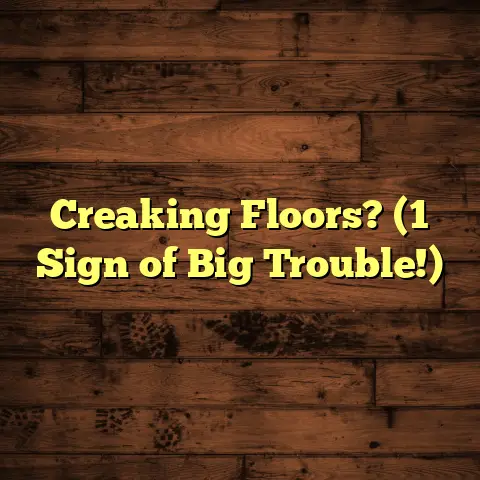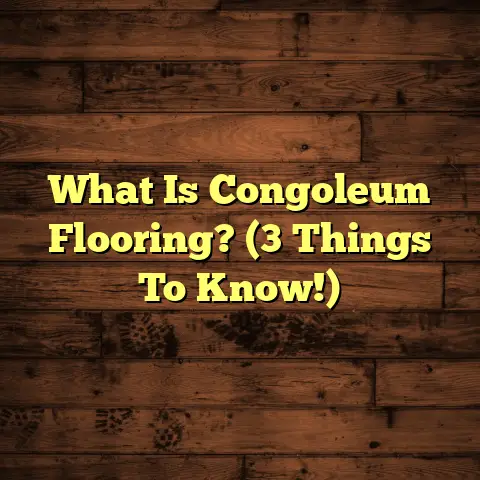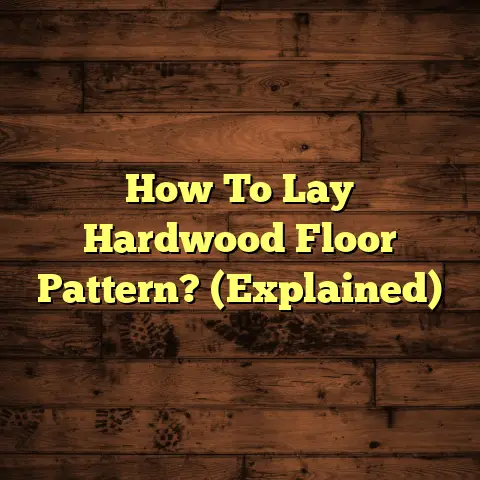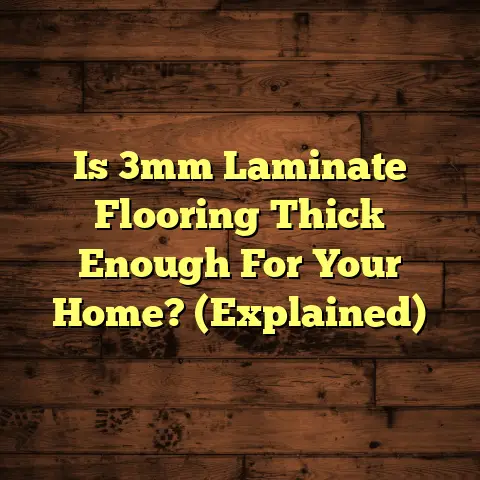Protecting Furniture With Floor Pads And Felt Stickers? (Explained)
Lately, I’ve noticed a growing trend among homeowners: protecting their floors and furniture has become a top priority. With the increasing variety of flooring options available, people want to maintain their investment while ensuring their living spaces remain beautiful and functional. A significant part of that protection strategy involves using floor pads and felt stickers.
I often find myself working on projects where clients have just installed beautiful new floors, whether it’s hardwood, laminate, or tile. The excitement of a fresh install can quickly turn to dismay when furniture is moved without proper precautions, leading to scratches and dents that mar the beauty of their investment. This experience has taught me how essential it is to use floor pads and felt stickers, especially for those who love rearranging furniture or have pets running around.
Why Floor Pads and Felt Stickers Matter
The importance of floor pads and felt stickers cannot be overstated. They serve as a protective barrier between your furniture and your flooring. Over the years, I have seen firsthand how these small additions can prevent significant damage and costly repairs. For example, I once worked on a project in a trendy downtown loft where the owner had invested heavily in high-quality oak flooring. Shortly after installation, they hosted a dinner party and moved heavy chairs without any protection. The result? Unsightly scratches that required refinishing the entire floor.
This incident reinforced my belief in the value of using floor pads and felt stickers to protect against everyday wear and tear.
The Basics of Floor Pads and Felt Stickers
Types of Floor Pads
Floor pads typically come in two main types:
- Rubber Pads: These are excellent for tile or concrete floors as they provide grip and prevent sliding. They are durable and can withstand heavy furniture without compressing too much over time.
- Foam Pads: These are softer and work well on hardwood or laminate floors. They absorb impact better than rubber and help prevent scratches.
Felt Stickers
Felt stickers are adhesive-backed pads that stick directly to the bottom of furniture legs. I often use them on chairs and tables because they glide effortlessly across the floor without causing damage. They’re available in various shapes and sizes, making them versatile for different furniture types.
Choosing the Right Option
When selecting floor pads or felt stickers, I consider several factors:
- Material: Felt is great for hardwood or laminate floors since it won’t scratch them. Rubber pads are excellent for preventing slipping on tiles or concrete.
- Thickness: Thicker pads provide more cushioning. I’ve found that 1/4 inch thickness works well for heavier furniture.
- Shape and Size: Make sure the pads fit your furniture properly. For example, round pads work best for chairs, while square ones suit tables.
Installation Tips
Installing floor pads or felt stickers is straightforward, but here are some tips to make it even easier:
- Clean the Furniture Legs: Before applying any sticker or pad, clean the bottom of the furniture legs to ensure a secure bond.
- Measure First: Use a ruler to measure the furniture legs so you can cut pads to size if necessary.
- Press Firmly: When applying felt stickers, press down firmly for a few seconds to ensure they stick well.
Maintenance and Care
Once you have installed your floor pads or felt stickers, regular maintenance is crucial. I always advise clients to check them periodically for wear and tear. If they start to peel or wear down, replace them immediately to prevent damage to the flooring.
Real-Life Experiences
In one instance, I worked on a commercial space where they opted for felt pads on heavy conference room chairs. After a few months, the office manager mentioned how much easier it was to slide chairs without worrying about scratches. They even saved money on maintenance costs because the floors remained unscathed.
Conversely, I faced challenges when some clients chose cheaper alternatives. They quickly learned that low-quality pads wore out faster, resulting in scratches on their newly installed floors. This experience taught me that investing in quality protection pays off in the long run.
Cost Estimation and Planning
Cost estimation is another critical aspect of any flooring project. I often rely on FloorTally to help manage budgets effectively. For instance, when I calculate costs for materials and labor, FloorTally provides accurate estimates based on local rates. This tool allows me to include the costs of floor pads and felt stickers in the overall budget, ensuring clients are aware of all expenses upfront.
For example, a recent project involved installing laminate flooring in a 1,200 square foot home. The estimate for materials came to about $3 per square foot, totaling $3,600. Adding in $100 for quality floor pads and felt stickers seemed reasonable given the investment in the flooring itself.
Comparing Options
In my experience, both floor pads and felt stickers serve their purpose well, but each has its advantages. Floor pads are reusable and can absorb impact better than felt stickers, making them ideal for heavy furniture. However, felt stickers are often more affordable and easier to apply.
For example, during one home renovation project, I used rubber floor pads under a heavy sofa and felt stickers under dining room chairs. The result was fantastic; the sofa remained stable without any slippage while the chairs glided smoothly across the floor.
Additional Considerations
The Role of Pets
If you’re a pet owner like me, you know that furry friends can be tough on floors. Dogs running through the house or cats jumping onto furniture can lead to scratches over time. I’ve found that using felt pads on furniture legs helps reduce noise when pets jump on and off surfaces while also protecting the floors from scratches caused by chair legs.
Environmental Impact
Another consideration is the environmental impact of your choices. Many felt pads are made from recycled materials, which is a bonus if you’re looking to make eco-friendly choices in your home design.
Aesthetics
Let’s not forget aesthetics! Floor pads come in various colors and designs, so you can choose options that complement your home decor. I often recommend my clients pick colors that match their furniture or flooring to create a seamless look.
Tips for Long-Term Protection
- Adjust Furniture Placement: If you’re moving heavy items frequently, consider spacing out your furniture in a way that minimizes movement across your floors.
- Use Area Rugs: Placing rugs in high-traffic areas can provide an extra layer of protection for your flooring while adding style to your space.
- Educate Family Members: Make sure everyone in your household understands the importance of using floor pads and stickers. Sometimes it only takes one family member moving furniture without thinking about protection to cause damage.
Troubleshooting Common Issues
Even with the best intentions, issues can arise with floor pads and felt stickers:
- Slipping Furniture: If you notice your furniture slipping despite using rubber pads, consider switching to heavier-duty options or using additional adhesive felt stickers for extra grip.
- Pads Wearing Out: If you find that your floor pads aren’t lasting as long as expected, reassess their material and thickness. Investing a little more initially can save you money in the long run by preventing damage.
Conclusion
Choosing the right protective measures for your floors is crucial for maintaining their beauty and functionality. I can’t stress enough how valuable it is to invest in quality floor pads and felt stickers. They not only protect your floors but also enhance your furniture’s usability.
If you’re considering flooring options in your home or business, remember that protecting your investment with these simple solutions can make a significant difference. Whether you’re moving furniture around or just want to keep everything looking pristine, these small additions can save you from larger headaches down the line.
So next time you’re planning a flooring project or simply rearranging your living room, don’t forget about those essential floor pads and felt stickers! They are small investments that yield big returns in floor protection.
In my journey as a flooring contractor, I’ve seen how these seemingly minor details significantly impact overall satisfaction with flooring installations. Protecting your furniture with floor pads and felt stickers isn’t just about avoiding scratches; it’s about preserving the integrity of your home environment.
Now that we’ve explored various aspects of protecting your floors with these tools, I’m curious—have you tried using floor pads or felt stickers before? What has been your experience? Share your thoughts!





